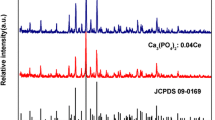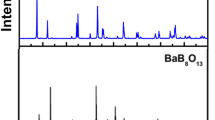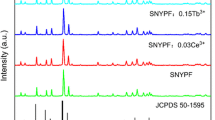Abstract
Ce3+-doped and Ce3+/Tb3+ co-doped Ca9Sr(PO4)6Cl2 phosphors were synthesized successfully via a traditional high-temperature solid-state reaction. The crystal structure, photoluminescent properties including temperature-dependent luminescence, and energy transfer of the as-prepared phosphors were investigated. The as-prepared Ca9Sr(PO4)6Cl2:Ce3+ phosphors exhibit a broad excitation band ranging from 220 to 385 nm and blue light-emitting band centered at 431 nm, which originate from the 4f–5d transitions of Ce3+ ion. The luminescent intensities of Tb3+ ions were dramatically enhanced by the introduction of Ce3+ in the Ca9Sr(PO4)6Cl2:Tb3+ phosphors because of the efficient energy transfer from Ce3+ to Tb3+ ions, generating tunable blue-green emission colors. The mechanism of energy transfer between Ce3+ and Tb3+ ions was demonstrated to be an electric dipole–quadrupole interaction. Moreover, the energy transfer efficiency was evaluated up to 75 % based on the analysis of the emission spectra. The temperature-dependent photoluminescence indicates that the as-prepared Ce3+/Tb3+ co-doped Ca9Sr(PO4)6Cl2 phosphors have excellent thermal stability. Our results suggest that the Ce3+-doped and Ce3+/Tb3+ co-doped Ca9Sr(PO4)6Cl2 phosphors have potential application for n-UV pumped WLEDs.










Similar content being viewed by others
References
Radkov E, Bompiedi R, Srivastava AM, Setlur AA, Becker C (2004) White light with UV LEDs. Proc SPIE 5187:171–177
Liang C, You HP, Fu YB, He JH (2015) A novel tunable blue-green-emitting CaGdGaAl2O7:Ce3+, Tb3+ phosphor via energy transfer for UV-excited white LEDs. Dalton Trans 44:8100–8106
Im WB, Brinkley S, Hu J, Mikhailovsky A, DenBaars SP, Seshadri R (2010) Sr2.97−xBaxCe0.025AlO4F: a highly efficient green-emitting oxyfluoride phosphor for solid state white lighting. Chem Mater 22:2842–2849
Guo CF, Jing H, Li T (2012) Green-emitting phosphor Na2Gd2B2O7:Ce3+, Tb3+ for near-UV LEDs. RSC Adv 2:2119–2122
Wu JL, Gundiah G, Cheetham AK (2007) Structure-property correlations in Ce-doped garnet phosphors for use in solid state lighting. J Chem Phys Lett 441:250–254
Lee GY, Han JY, Im WB, Cheong SH, Jeon DY (2012) Novel blue-emitting Na x Ca1−x Al2−x Si2+x O8:Eu2+ (x = 0.34) phosphor with high luminescent efficiency for UV-pumped light-emitting diodes. Inorg Chem 51:10688–10694
Lin HC, Yang CY, Das S, Chung-Hsin Lu (2014) Photoluminescence properties of color-tunable Ca3La6(SiO4)6:Ce3+, Tb3+ phosphors. J Am Ceram Soc 97:1866–1872
Duan CJ, Zhang ZJ, Rosler S, Delsing A, Zhao JT, Hintzen HT (2011) Preparation, characterization, and photoluminescence properties of Tb3+, Ce3+, and Ce3+/Tb3+-activated RE2Si4N6C (RE = Lu, Y, and Gd) phosphors. Chem Mater 23:1851–1861
Cao CY, Yang HK, Chung JW, Moon BK, Choi BC, Jeong JH, Kim KH (2011) Hydrothermal synthesis and enhanced photoluminescence of Tb3+ in Ce3+/Tb3+ doped KGdF4 nanocrystals. J Mater Chem 21:10342–10347
Maggay IVB, Lin PC, Liu WR (2015) Investigation of luminescence properties and the energy transfer mechanism of Li6Lu(BO3)3:Ce3+, Tb3+ green-emitting phosphors. RSC Adv 5:5591–5597
Xia ZG, Wu WW (2013) Preparation and luminescence properties of Ce3+ and Ce3+/Tb3+-activated Y4Si2O7N2 phosphors. Dalton Trans 42:12989–12997
Nohara A, Takeshita S, Isobe T (2014) Mixed-solvent strategy for solvothermal synthesis of well-dispersed YBO3:Ce3+, Tb3+ nanocrystals. RSC Adv 4:11219–11224
Chen MY, Xia ZG, Liu QL (2015) Luminescence properties and energy transfer of Ce3+/Tb3+ co-doped Ca6Ba(PO4)4O phosphor for near-UV pumped light-emitting diodes. J Mater Chem C 3:4197–4204
Park WB, Singh SP, Pyo M, Sohn KS (2011) Y6+x/3Si11−yAlyN20+x−yO1−x+y:Re3+ (Re = Ce3+, Tb3+, Sm3+) phosphors identified by solid-state combinatorial chemistry. J Mater Chem 21:5780–5785
Sayed FN, Grover V, Godboleb SV, Tyagi AK (2012) Color tunable YF3:Ce3+/Ln3+ (Ln3+: Eu3+, Tb3+, Dy3+, Sm3+) luminescent system: role of sensitizer and energy transfer study. RSC Adv 2:1161–1167
Jia D, Meltzer RS, Yen WM, Jia W, Wang X (2002) Green phosphorescence of CaAl2O4:Tb3+, Ce3+ though persistence energy transfer. Appl Phys Lett 80:1535–1537
Zhou XF, Zhang ZY, Wang YH (2015) Ce3+ and Tb3+ singly- and co-doped MgGd4Si3O13 for ultraviolet light emitting diodes and field emission displays. J Mater Chem C 3:3676–3683
Shmulovich J, Berkstresser GW, Brasen D (1985) Tb3+-Ce3+ energy transfer in Tb3+/Ce3+: YAG single crystals. J Chem Phys 82:3078–3082
Blesse G, Bril A (1967) Study of energy transfer from Sb3+, Bi3+, Ce3+ to Sm3+, Eu3+, Tb3+, Dy3+. J Chem Phys 47:1920–1926
Sahu NK, Singh NS, Pradhan L, Bahadur D (2014) Ce3+ sensitized GdPO4:Tb3+ with iron oxide nanoparticles: a potential biphasic system for cancer theranostics. Dalton Trans 43:11728–11738
Pazik R, Nedelec JM, Wiglusz RJ (2014) Preferential site substitution of Eu3+ ions in Ca10(PO4)6Cl2 nanoparticles obtained using a microwave stimulated wet chemistry technique. CrystEngComm 16:5308–5318
Notzold D, Wulff H, Herzo G (1995) Structural and optical properties of the system (Ca, Sr, Eu)(PO4)3Cl. Phys Stat Sol 191:21–30
Wang CH, Gui DY, Qin R, Yang FL, Jing XP, Tian GS, Zhu WJ (2013) Site and local structure of activator Eu2+ in phosphor Ca10−x(PO4)6Cl2:xEu2+. J Solid State Chem 206:69–74
Babu R, Jena H, Govindan Kutty KV, Nagarajan K (2011) Thermodynamic functions of Ba10(PO4)6Cl2, Sr10(PO4)6Cl2 and Ca10(PO4)6Cl2. Thermochim Acta 526:78–82
Fu ZL, Wang XJ, Yang Y, Wu ZJ, Duana DF, Fu XH (2014) Hydrothermal synthesis, electronic structure and tunable luminescence of single-phase Ca5(PO4)3F:Tb3+/Eu3+ microrods. Dalton Trans 43:2819–2827
Zhou L, Liang HB, Peter AT, Zhang Su, Hou DJ, Liu CM, Tao Y, Huang Y, Li LN (2013) Luminescence, cathodoluminescence and Ce3+/Eu2+ energy transfer and emission enhancement in the Sr5(PO4)3Cl:Ce3+, Eu2+ phosphor. J Mater Chem C 1:7155–7165
Wu JL, Gundiah G, Cheetham AK (2007) Structure-property correlations in Ce-doped garnet phosphors for use in solid state lighting. Chem Phys Lett 441:250–254
Zhang XG, Gong ML (2014) Single-phased white-light-emitting NaCaBO3:Ce3+, Tb3+, Mn2+ phosphors for LED applications. Dalton Trans 43:2465–2472
Wang DY, Huang CH, Wu YC, Chen TM (2011) BaZrSi3O9:Eu2+: a cyan-emitting phosphor with high quantum efficiency for white light-emitting diodes. J Mater Chem 21:10818–10822
Blasse G (1969) Energy transfer in oxidic phosphors. Philips Res Rep 24:131–136
Antipeuko BM, Bataev IM, Ermolaev VL, Privalova TA (1970) Ion-to-ion radiationless transfer of electron excitation energy between rare-earth ions in POCl3-SnCl4. Opt Spektrosk 29:335
Ozawa L, Jaffe PM (1971) The mechanism of the emission color shift with activator concentration in Eu3+ activated phosphors. J Electrochem Soc 118:1678–1679
Van Uitert L (1976) Characterization of energy transfer interactions between rare earth ions. J Electrochem Soc 114:1048–1053
Cheng SD, Kam CH, Buddhudu S (2001) Enhancement of green emission from Tb3+: GdOBr phosphors with Ce3+ ion co-doping. Mater Res Bull 36:1131–1137
Dong J, Wang L, Cui CE, Tian Y, Huang P (2015) Luminescence properties of Ce3+-doped and Ce3+-Tb3+ co-doped Na0.34Ca0.66Al1.66Si2.34O8 phosphor for UV-LED. Ceram Int 41:1341–1346
Bourcet JC, Fong FK (1974) Quantum efficiency of diffusion limited energy transfer in La1−x−yCexTbyPO4. J Chem Phys 60:34–39
Dexter DL, Schulman JH (1954) Theory of concentration quenching in inorganic phosphors. J Chem Phys 22:1063–1070
Reisfeld R, Greenberg E, Velapoldi R, Barnett B (1972) Luminescence quantum efficiency of Gd and Tb in borate glasses and the mechanism of energy transfer between them. J Chem Phys 56:1698–1705
Hsu CH, Lu CH (2011) Structural and optical characteristics of CeSi3N5:Tb3+ nitridosilicate phosphors. J Am Ceram Soc 94:1320–1323
Reisfeld R, Lieblich-Soffer N (1979) Energy transfer from UO2 2+ to Sm3+ in phosphate glass. J Solid State Chem 28:391–395
Blasse G, Grabmaier BC (1994) Luminescent Materials. Springer, Berlin, pp 91–107
Geng K, Xia ZG, Molokeev MS (2014) Crystal structure and luminescence property of a novel blue-emitting Cs2xCa2xGd2(1−x)(PO4)2:Eu2+ (x = 0.36) phosphor. Dalton Trans 43:14092–14098
Acknowledgements
This work was partially supported by the National Natural Science Foundation of China (NSFC, 51302182), the National High Technology Research and Development Program (“863” Program) of China (2015AA016901), the Qualified Personnel Foundation of Taiyuan University of Technology (QPFT) (No: tyut-rc201361a), and the Program for the outstanding Innovative Teams of Higher Learning Institutions of Shanxi.
Author information
Authors and Affiliations
Corresponding authors
Rights and permissions
About this article
Cite this article
Feng, L., Tian, Y., Wang, L. et al. Tunable emission, energy transfer, and thermal stability of Ce3+-doped and Ce3+/Tb3+ Co-doped Ca9Sr(PO4)6Cl2 phosphors. J Mater Sci 51, 2841–2849 (2016). https://doi.org/10.1007/s10853-015-9592-x
Received:
Accepted:
Published:
Issue Date:
DOI: https://doi.org/10.1007/s10853-015-9592-x




